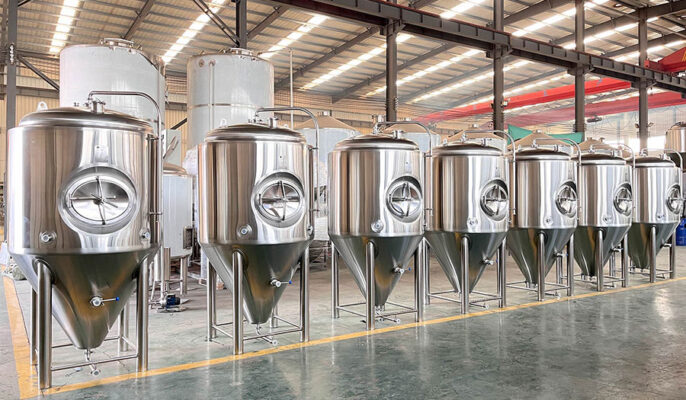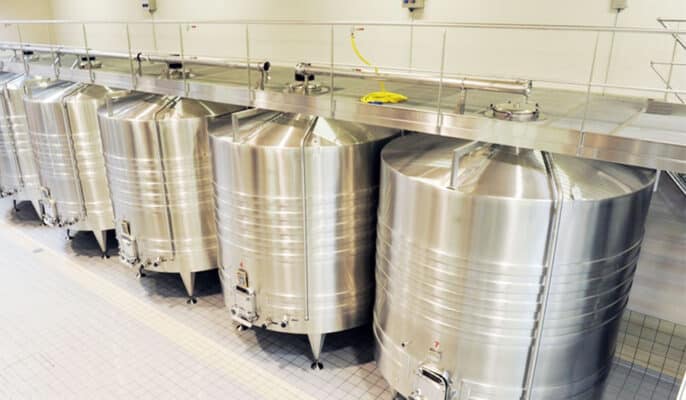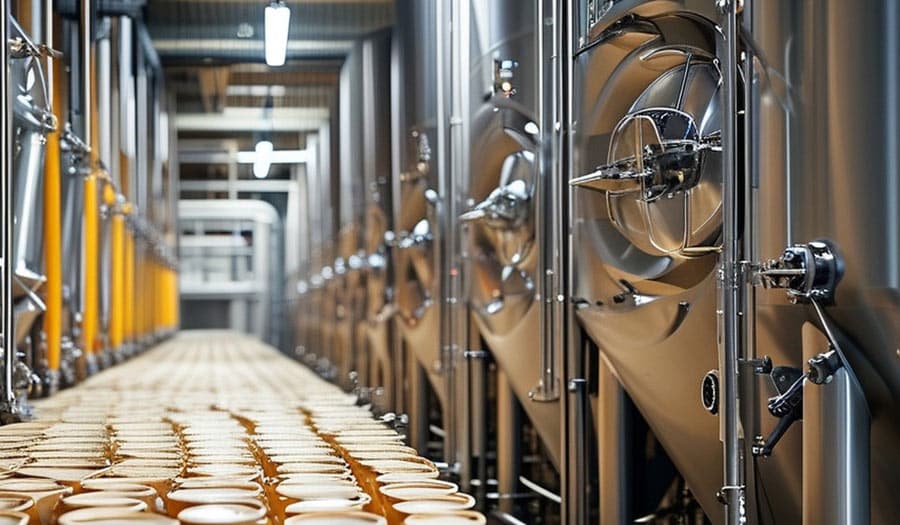I serbatoi conici in acciaio inox per la fermentazione della birra rappresentano una delle attrezzature chiave per la produzione di birra, in quanto combinano la resistenza alla corrosione con un design conico per garantire un processo di fermentazione efficiente e igienico. Il corpo del serbatoio di fermentazione è solitamente realizzato in acciaio inox di alta qualità, che garantisce un'eccellente durata e facilità di pulizia, supportando perfettamente il controllo della temperatura e la gestione del lievito nel processo di produzione della birra. In questo articolo, è possibile esplorare a fondo il processo di fermentazione dei serbatoi di birra, comprendendone la struttura e la funzione.
Che cos'è un cono in acciaio inox serbatoio di fermentazione?
I serbatoi di fermentazione, noti anche come serbatoi di fermentazione o recipienti di fermentazione, sono contenitori utilizzati per contenere substrati come il mosto o il succo d'uva per la fermentazione. Questi serbatoi forniscono l'ambiente necessario al lievito o ad altri microrganismi per convertire gli zuccheri in alcol e anidride carbonica. I serbatoi di fermentazione conici in acciaio inox sono un tipo di attrezzatura professionale utilizzata per la birra o altre bevande fermentate. La caratteristica principale dei serbatoi di fermentazione conici in acciaio inox è che sono realizzati con materiali in acciaio inox di alta qualità e sono progettati a forma conica. Ecco le sue principali caratteristiche e funzioni:
- Materiale: I serbatoi di fermentazione conici in acciaio inox utilizzano solitamente acciaio inox 304 o 316, che hanno un'eccellente resistenza alla corrosione e durata, e possono rimanere igienici e stabili nell'uso a lungo termine.
- Design conico: Il design conico consente ai sedimenti prodotti durante il processo di fermentazione (come lieviti, proteine, ecc.) di concentrarsi naturalmente sul fondo del serbatoio. In questo modo, i birrai possono rimuovere facilmente questi sedimenti senza mescolarli al prodotto finale, ottenendo una birra più limpida.
- Sistema di controllo della temperatura: Molti serbatoi di fermentazione conici in acciaio inox sono dotati di un sistema di controllo della temperatura per garantire che il processo di fermentazione si svolga entro l'intervallo di temperatura ottimale. Questo è essenziale per la salute del lievito e la qualità della fermentazione.
- Valvola di scarico e porta di campionamento: Questi serbatoi sono solitamente dotati di valvole di drenaggio per lo scarico regolare dei sedimenti e di porte di campionamento per consentire ai produttori di birra di effettuare ispezioni di qualità e raccolta di campioni.
- Pulizia e manutenzione: L'acciaio inossidabile rende questi serbatoi facili da pulire e da mantenere, impedendo la crescita di microrganismi e garantendo l'igiene del processo di fermentazione.
- Tenuta: I serbatoi di fermentazione conici sono solitamente dotati di una buona tenuta, in grado di impedire efficacemente l'ingresso di aria e sostanze inquinanti, controllando al contempo il rilascio di anidride carbonica e mantenendo un ambiente di fermentazione stabile.

Tipi di serbatoio di fermentazione conico in acciaio inox
Il design e la funzione di un serbatoio di fermentazione possono influenzare notevolmente l'efficienza del processo di fermentazione e la qualità del prodotto. Esistono tre tipi principali di fermentatori comuni: aperto, chiuso e a capacità variabile. Di seguito analizzeremo in dettaglio le caratteristiche e gli scenari di applicazione di ciascun tipo.
Vasca di fermentazione aperta
Un serbatoio di fermentazione aperto è un semplice contenitore senza coperchio o dispositivo di chiusura. Questo design consente alla parte superiore del serbatoio di essere sempre esposta all'aria, il che è comodo per il funzionamento e l'accesso manuale. I serbatoi di fermentazione aperti sono molto diffusi nella vinificazione perché, durante la fermentazione dell'uva, le bucce e i vinaccioli che galleggiano sulla superficie del liquido devono essere pressati o mescolati regolarmente per garantire una fermentazione uniforme. Sebbene questo tipo di serbatoio sia comodo da utilizzare, la sua esposizione all'aria lo rende più suscettibile ai contaminanti esterni.
Serbatoio di fermentazione chiuso
Il serbatoio di fermentazione chiuso è dotato di un coperchio sigillato progettato per impedire l'ingresso di qualsiasi contaminante esterno nel serbatoio. Questo design sigillato è particolarmente importante per la produzione di birra, perché è in grado di isolare efficacemente l'aria e di prevenire l'ossidazione e la contaminazione, riducendo così il rischio di deterioramento e la generazione di odori. I fermentatori chiusi non solo mantengono un ambiente di fermentazione stabile, ma controllano anche meglio il rilascio di gas e le variazioni di temperatura durante la fermentazione, garantendo alla birra una qualità superiore.
Vasca di fermentazione a volume variabile
I fermentatori a volume variabile hanno un design flessibile e sono solitamente dotati di un coperchio galleggiante e di impostazioni di volume regolabili. Questo design consente agli utenti di regolare il volume del fermentatore a seconda delle necessità, rendendolo ideale per i birrai domestici e per i piccoli birrifici. La flessibilità dei serbatoi di fermentazione a volume variabile non solo consente di ospitare diverse quantità di liquido di fermentazione, ma riduce anche al minimo il contatto del liquido di fermentazione con l'aria, migliorando così la qualità e la stabilità della fermentazione. La versatilità di questo serbatoio lo rende popolare nei piccoli ambienti di produzione della birra.
Il ruolo dei serbatoi di fermentazione conici in acciaio inossidabile nel processo di produzione della birra
I serbatoi di fermentazione conici in acciaio inox svolgono un ruolo fondamentale nel processo di produzione della birra e il loro design e le loro funzioni offrono molti vantaggi al processo di fermentazione. Ecco alcune caratteristiche chiave e il loro impatto sulla qualità della fermentazione:
- Ambiente controllato: I serbatoi di fermentazione conici in acciaio inossidabile offrono un ambiente di fermentazione sigillato e controllato, in grado di isolare efficacemente i contaminanti esterni come lieviti selvatici, batteri e piccole particelle nell'aria. Questo design sigillato non solo protegge la purezza del prodotto fermentato, ma garantisce anche la stabilità del processo di fermentazione, contribuendo a mantenere alta la qualità del prodotto.
- Regolazione della temperatura: Molti fermentatori, soprattutto quelli chiusi, sono dotati di sistemi avanzati di controllo della temperatura. La temperatura è un fattore cruciale nel processo di fermentazione perché influisce direttamente sul metabolismo e sulle dinamiche di fermentazione del lievito. Controllando con precisione la temperatura, il fermentatore può garantire che il lievito lavori nelle migliori condizioni, ottimizzando così le caratteristiche organolettiche e la qualità complessiva del prodotto finale.
- Agitazione e miscelazione: Alcuni serbatoi di fermentazione in acciaio inox sono dotati di agitatori integrati per un'efficace miscelazione del liquido. Un'agitazione adeguata non solo contribuisce a una fermentazione uniforme, ma migliora anche l'effetto del controllo della temperatura e favorisce la salute del lievito. Questo aspetto è particolarmente importante per i fermentatori di grande capacità, perché una miscelazione uniforme può ridurre le differenze di temperatura locali e la distribuzione non uniforme del lievito.
- Separazione dei sedimenti: I serbatoi di fermentazione conici sono progettati specificamente per gestire i sedimenti prodotti durante la fermentazione. Il fondo conico consente al lievito e ad altri sedimenti di depositarsi naturalmente sul fondo, semplificando il successivo processo di rimozione. Questo design non solo facilita la rimozione dei sedimenti, ma migliora anche l'efficienza della filtrazione e della lavorazione del prodotto finale.
- Carbonazione: Alcuni serbatoi di fermentazione, soprattutto quelli unitari, hanno anche la funzione di gestire la carbonazione. Al termine della fermentazione, questi serbatoi possono essere carbonati nello stesso contenitore senza trasferire il liquido in un altro. Questa funzione integrata non solo fa risparmiare tempo e manodopera, ma riduce anche il rischio di contaminazione che può essere introdotto durante il processo di trasferimento.
Quanti serbatoi di fermentazione Ho bisogno di un prodotto per il mio processo di birrificazione?
Dimensione del lotto
La capacità del lotto è il fattore fondamentale per determinare il numero di serbatoi di fermentazione necessari. Più grande è il lotto, più serbatoi di fermentazione saranno generalmente necessari, ma questa relazione non è sempre lineare e occorre considerare fattori quali il tempo di fermentazione, i tempi di pulizia e manutenzione delle apparecchiature e la produzione desiderata. Ad esempio, se l'obiettivo è mantenere una produzione settimanale costante, è necessario disporre di un numero sufficiente di serbatoi di fermentazione per scaglionare efficacemente i cicli di produzione.
Capacità produttiva
Determinare la quantità di birra che si intende produrre in un determinato periodo di tempo. Questo può essere settimanale, mensile o annuale. Calcolate il volume totale di birra che volete produrre e dividetelo per la dimensione del lotto per avere un'idea di quanti lotti dovrete fermentare. La determinazione del ciclo medio di fermentazione per ogni tipo di birra è uno dei fattori chiave per calcolare la capacità produttiva.
Per calcolare il numero di fermentatori necessari, dividere la produzione prevista per la dimensione del lotto. In questo modo si ottiene il numero minimo di serbatoi necessari per raggiungere la produzione mensile desiderata.
Ad esempio, se la produzione prevista è di 4.000 litri al mese e la dimensione del lotto è di 1.000 litri, il numero di fermentatori necessari è di almeno 4. Tuttavia, è importante considerare fattori pratici come la manutenzione, la pulizia e la sovrapposizione dei lotti. La presenza di fermentatori aggiuntivi può aiutare a gestire questi fattori e a garantire operazioni più fluide. Si consiglia di aggiungere un cuscinetto aumentando il numero di fermentatori a un livello leggermente superiore al requisito minimo.
Tipo di fermentazione e requisiti specifici
Ogni processo di fermentazione ha requisiti unici. La produzione di birra, di vino, di aceto o di prodotti lattiero-caseari fermentati richiede condizioni specifiche, come il controllo della temperatura, l'esposizione all'ossigeno o il tempo di invecchiamento. Comprendere le complessità del tipo di fermentazione scelto può aiutare a scegliere il numero e il tipo di serbatoi di fermentazione appropriati.
Stima del tempo di fermentazione
Se si prevede di eseguire più fermentazioni contemporaneamente, ciò influisce sul numero di serbatoi di fermentazione necessari. La gestione di prodotti o lotti diversi contemporaneamente richiede fermentatori aggiuntivi e un'attenta programmazione per evitare contaminazioni incrociate o interferenze tra le fermentazioni. La possibilità di scaglionare le fermentazioni e di ottimizzare l'uso dei fermentatori può aiutare a mantenere un programma di produzione coerente.
Se un lotto di un prodotto impiega 10 giorni per fermentare e il vostro obiettivo è preparare un nuovo lotto ogni 10 giorni, avete bisogno di un numero sufficiente di fermentatori per mantenere questo ciclo. Ciò può significare 10 fermentatori per consentire a ogni lotto di fermentare in modo indipendente senza dover aspettare che il lotto precedente finisca.
Flessibilità e versatilità
Considerate un mix di serbatoi di fermentazione di diverse dimensioni per aumentare la flessibilità operativa. I fermentatori più piccoli offrono versatilità per lotti sperimentali, edizioni limitate o prodotti di nicchia. D'altro canto, i serbatoi di fermentazione più grandi possono ospitare produzioni standard e contribuire a migliorare l'efficienza complessiva. Questa combinazione consente di adattarsi alle richieste del mercato e di sperimentare nuove ricette.
Considerare la sovrapposizione dei cicli
L'utilizzo efficace dei fermentatori comporta la sovrapposizione dei cicli di fermentazione. Mentre un lotto è in fermentazione, un altro lotto può iniziare o terminare. In questo modo si riducono al minimo i tempi di inattività e si massimizza la resa. A seconda dei tempi di fermentazione, se i cicli si sovrappongono in modo efficace, potrebbero essere necessari meno serbatoi di fermentazione rispetto al numero di lotti prodotti.
Vincoli infrastrutturali e di spazio
Le limitazioni dello spazio e delle infrastrutture disponibili possono limitare il numero di serbatoi disponibili in una determinata area. È fondamentale trovare un equilibrio tra efficienza operativa e spazio disponibile. L'utilizzo efficace dell'infrastruttura esistente può richiedere l'investimento in fermentatori più grandi o l'ottimizzazione del layout per migliorare il flusso di lavoro. Assicurarsi che la struttura soddisfi gli standard di sicurezza e di igiene, tenendo conto della possibilità di espansione futura.
Budget e allocazione delle risorse
Infine, i vincoli di budget possono influire sul numero di fermentatori che si possono acquistare inizialmente. Può essere fattibile iniziare con un numero ridotto di fermentatori versatili e poi aumentare gradualmente in base alle esigenze di produzione e alle capacità finanziarie. Quando si calcola il numero di fermentatori, è necessario adeguare il piano in base ai vincoli di bilancio. Per bilanciare il numero ideale di fermentatori e le considerazioni finanziarie può essere necessario investire per fasi e stabilire le priorità in base alle esigenze attuali. Valutando attentamente le dinamiche dei lotti, i tempi di fermentazione, la scala di produzione, il tipo di fermentazione e le esigenze di flessibilità, è possibile personalizzare l'infrastruttura dei serbatoi di fermentazione per ottimizzare l'efficienza e soddisfare i requisiti specifici del proprio lavoro di fermentazione. Naturalmente, potete anche contattare il gruppo Micet e gli ingegneri svilupperanno una soluzione adatta a voi.

Come scegliere il giusto serbatoio di fermentazione conico in acciaio inox?
- Capacità: Determinare la scala di produzione della birra per scegliere la giusta capacità del serbatoio. Per la produzione casalinga o per i piccoli birrifici, i serbatoi di fermentazione più piccoli possono essere più adatti, mentre la produzione su larga scala richiede serbatoi di maggiore capacità. Assicuratevi che la capacità del serbatoio corrisponda alle vostre esigenze di produzione per migliorare l'efficienza e la flessibilità.
- Sistema di controllo della temperatura: Se è necessario controllare con precisione la temperatura di fermentazione, è fondamentale scegliere un serbatoio di fermentazione dotato di un sistema di controllo della temperatura avanzato. Assicuratevi che il sistema di controllo della temperatura sia in grado di fornire una regolazione stabile della temperatura per supportare una gestione precisa del processo di fermentazione e ottimizzare l'attività del lievito e il sapore del prodotto finale.
- Materiale: L'acciaio inox di alta qualità (come l'acciaio inox 304 o 316) è un criterio importante nella scelta di un serbatoio di fermentazione. Questi materiali non solo hanno un'eccellente resistenza alla corrosione e durata, ma semplificano anche il processo di pulizia e manutenzione, mantenendo il serbatoio igienico e in uso a lungo termine.
- Caratteristiche del design: Prestare attenzione ai dettagli di progettazione del serbatoio di fermentazione, tra cui l'angolo del fondo conico, la posizione e le dimensioni della valvola di scarico, ecc. Queste caratteristiche influiscono direttamente sulla gestione dei sedimenti e sull'efficienza di pulizia del serbatoio. La scelta del design giusto può migliorare la convenienza e l'efficacia del processo di fermentazione.
- Capacità di agitazione e miscelazione: Per i processi di fermentazione che richiedono una miscelazione uniforme, la scelta di un serbatoio di fermentazione con agitatore incorporato contribuirà a garantire l'uniformità del liquido di fermentazione. Ciò non solo favorisce la salute del lievito, ma migliora anche la consistenza e l'efficienza del processo di fermentazione, particolarmente importante quando si tratta di fermentazioni di grandi volumi.
- Gestione dei gas: Assicurarsi che il fermentatore sia dotato di un efficace sistema di scarico dei gas per gestire correttamente l'anidride carbonica prodotta durante il processo di fermentazione. In questo modo si evita una pressione eccessiva e si mantiene la stabilità del serbatoio per evitare possibili tracimazioni o altri problemi.
- Budget: Scegliere il giusto fermentatore in base al proprio budget. I prezzi dei fermentatori di diverse marche e funzioni variano notevolmente. Soppesate le prestazioni e il prezzo e scegliete l'attrezzatura più conveniente per soddisfare le vostre esigenze e controllare i costi.
- Fornitori e servizi: La scelta di un fornitore affidabile è un passo importante per garantire la qualità dell'apparecchiatura e dei servizi successivi. Analizzate le recensioni dei clienti e i record di assistenza del fornitore per assicurarvi di poter ottenere un'assistenza post-vendita di alta qualità e la soluzione dei problemi dopo l'acquisto.
FAQ
Che cos'è un serbatoio di fermentazione conico in acciaio inox?
Un serbatoio di fermentazione conico in acciaio inossidabile è un'apparecchiatura di fermentazione in acciaio inossidabile di alta qualità con un design a fondo conico, appositamente progettato per la produzione di birra o altre bevande fermentate.
Perché scegliere l'acciaio inossidabile?
L'acciaio inossidabile ha eccellenti caratteristiche di resistenza alla corrosione, durata e facilità di pulizia. Può prevenire la contaminazione, garantire l'igiene del processo di fermentazione e prolungare la durata del serbatoio.
Come scegliere la giusta capacità del serbatoio di fermentazione?
La capacità deve essere determinata in base alla scala di produzione della birra. La produzione casalinga o la piccola produzione richiedono solitamente un serbatoio di capacità inferiore, mentre la produzione su larga scala richiede un serbatoio di capacità superiore. Assicuratevi che la capacità soddisfi le vostre esigenze di produzione per migliorare l'efficienza e la flessibilità.
Quali sono i vantaggi del design conico?
Il design del fondo conico consente ai sedimenti generati durante il processo di fermentazione di depositarsi naturalmente sul fondo del serbatoio per essere facilmente rimossi. Questo design contribuisce a mantenere la limpidezza del liquido di fermentazione e semplifica il processo di pulizia e filtrazione.




